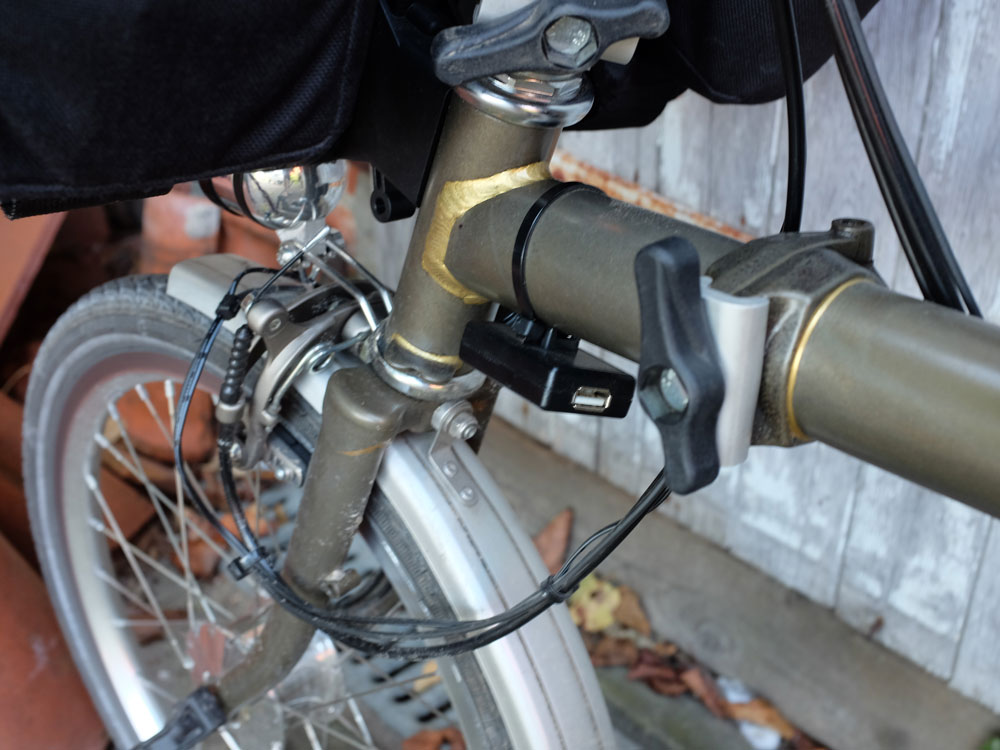My Garmin satnav and smartphone are both power hungry devices. Typically both last about a day before needing to be recharged, but of course this depends on how much it gets used, so sometimes they needed to be charged before the day was out.
In preparation ahead of the trip I purchased a Sinewave Cycles Revolution AC/DC converter, which I piggy-backed onto the hub dynamo.
Here is the converter mounted underneath the main frame tube:

The output of the dynamo is alternating current. This device turns it into 5V DC, with a maximum output of 1A depending how fast you pedal. From their website:
Starts charging at 3.5 MPH (5.5 km/h)
Full charging at 9 MPH (14.4km/h)
It’s fully waterproof. I mounted it here so a cable plugged into it would have some protection against the weather. It also doesn’t interfere with the fold in this position.
As it was piggy-backed onto the dynamo connectors, this meant it was able to charge whenever it wasn’t dark enough for my lights to come on.
From the output of the Sinewave device I ran a USB cable into a Limefuel battery which I kept in the front touring bag. This battery has the ability to be charged at the same time as charging a device which is a nifty feature that not all battery packs do.
Then, from the Sinewave device I ran a USB cable to whatever required charging.
To start off I kept the battery in the left hand outer pocket of the touring bag, but found the USB cables got damaged from the movement (two USB cables destroyed in this manner) so afterwards kept the battery in the main bag compartment, laid on top everything else in there.
I had considered adding modding my front touring bag so the electrical connections were automatic, but didn’t want to risk weakening the luggage system ahead of the tour.
It worked reasonably well, but to charge my phone and the GPS device each day required a good day’s cycling, i.e. around 100km at reasonable speeds (i.e. not hilly). Charging just the Garmin alone each day would be no problem, but the phone uses up a lot of power when using it to upload pics when blogging and just general internet use.
To prevent my phone from running out of charge I found it was a huge help to set it to ‘airplane’ mode to switch off all the services I didn’t need. Then it could still be used as a camera to take pictures for the blog.
I found it best to charge the Garmin when not using it for navigation. The reason for this is that when you plug a USB cable into the Garmin and have it switched on, the backlight comes on and there is no way to switch this off, and the backlight is one of the major contributors to battery drainage.
My honed routine was thus as follows:
- When setting off in the morning, I connected the Limefuel battery to the Sinewave converter so it charged all day long.
- I set my phone to ‘airplane’ mode.
- In the evening if arriving at a campsite, I would upload my day’s ride from the Garmin device to the internet, then plug the Garmin into the battery to charge and switch it off. It would take a couple of hours to charge, so after dinner etc. once charged, I would then charge up my phone. Where available I also used campsite facilities to top up the battery from a wall socket.
- In the evening if arriving at a hotel, I would do the same, but when charging my phone I would also plug the battery into a wall socket in my room to recharge.
There is a very good argument for just using bigger / more battery packs so consider this as a good option. E.g. take a 2 port 2A USB hub that plugs into the mains, and a couple of larger battery packs. Assuming you do find somewhere you can plug in every 4 days you should be ok.
Back to European Cycle Tour main page.
Thanks for the link. I thought you may be interested to know that the modified luggage block from my post is still in daily use nearly four and a half years later with not problems. I’ve probably covered about 10,000 miles on the Brompton in that time.
That’s great – I’ve still yet to make the mod, but intend to get around to it at some point 🙂